On Wednesday of last week, the Portland Parks & Recreation Bureau hosted a Project Advisory Committee (PAC) meeting for the River View Natural Area. It was the first such meeting in 14 months for the group charged with developing a management plan for the 146-acre parcel.
Mountain bike advocates have been eager to re-engage with the process and learn more about why their activity was banned by Commissioners Amanda Fritz and Nick Fish last month. (Prior to the city’s purchase of River View, Portlanders had ridden bikes on its many trails for over two decades.) That decision came without warning and was made completely outside of the established public process.
The decision has made Portland a national embarrassment.
While he can’t keep Portland’s anti-mountain biking stances out of the headlines, at Wednesday’s meeting Parks Director Mike Abbaté did his best to make sure the topic of biking remained out of the public process around River View.
Here’s Abbaté attempt at doing that in his opening address to the committee and the assembled public:
“Tonight, we can’t address the change in policy direction that restricts mountain biking use on the site. That’s not the topic of the meeting tonight and we’re not going to talk about that… What we’re really here for today is moving forward the planning process that protects the natural resources of the site and compatible uses. As such, bicycling will not be considered — yay or nay — as part of this management plan.”
Several times in the course of the meeting, Abbaté and Parks planner Emily Roth were forced to repeat that they could not talk about the mountain biking decision.
“Why is cycling considered not compatible?” asked committee member and Northwest Trail Alliance representative Brian Baumann. “We have not made that decision,” Roth replied. “Then why is it restricted?” Baumann followed, “At this time, we’re just not allowed to talk about it at this moment.”
I tracked down Parks Director Abbaté when he left and asked him myself. “I can’t talk about it Jonathan, I just can’t talk about it,” he said.
This echoes what Parks announced in early April when they re-opened the public process. They also told their Technical Advisory Committee to carry on without biking in the mix.
The silence around cycling is likely due to the pending legal action against the city by the Northwest Trail Alliance.
Even before that legal filing, Abbaté, Roth, and their boss, Parks Commissioner Fritz, wanted all discussions of mountain biking in city parks to happen within the Off-Road Cycling Master Plan process. Yet despite talking like the plan is inevitable, it isn’t funded and it remains to be seen whether City Council will authorize its $350,000 price tag.
Advertisement
This sudden silence around cycling was a bit awkward on Wednesday because two members of Project Advisory Committee (PAC) were there specifically to represent the activity: Charlie Sponsel, a professional rider; and Baumann with the Northwest Trail Alliance. Sponsel recently led a large protest rally in River View and it’s Baumann’s group that has filed an intent to appeal the Commissioners’ bike ban decision with the State’s Land-Use Board of Appeals.
“I’m not sure about the wisdom of finalizing the trail system before we’ve finalized the decision of trail uses.”
— Jay Withgott, Audubon Society of Portland
After Abbaté’s opening remarks, Sponsel asked the obvious question: “If we’re not going to discuss mountain biking, why are Brian and I here and how are you hoping we can contribute?”
Abbaté replied by telling Sponsel his perspective should not be “narrowly defined to focus on bike issues” and that his input in the River View process could help inform the Off-Road Cycling Master Plan.
Sponsel was very active during the meeting. He dogged Parks staff with a constant stream of questions that forced them to address not just bicycling’s future at River View but a myriad of other trail and access issues. His questions, combined with Baumann’s clear voice of opposition, resulted in a meeting that ended up with some positives for bike advocates, not to mention a few more supporters.
For Parks, the meeting didn’t go as planned. Instead of moving forward and getting committee endorsements of their draft trail plan prior to an upcoming open house event on May 4th, they’ve been left with more work to do and some tough questions to ponder.
Once the committee got to work, Parks’ Natural Resources Planner Emily Roth (she was also the agency’s point person on the Forest Park singletrack process) introduced the latest “access concept” map. This map shows two phases of a hiking-only trail that runs just over four miles and stays mostly around the outside edge of the parcel.
This draft map raises concerns for bike advocates for several reasons: It was created (mostly) in secret by the Technical Advisory Committee without input from the PAC; it includes no trails built for bicycling; and it leaves a large interior section of the parcel devoid of public access.
On the other side of the debate, Jennifer Seamans, manager of the Southwest Watershed Resource Center, offered support for Parks’ current plan. “There are very few or no other areas like this in the city,” she said, “This is an unprecedented opportunity for a relatively in-tact watershed and I think Parks is right to recommend that we protect that interior habitat.”
The decision to endorse the draft access map is important, because of something Roth made clear at the outset meeting. “If, through the citywide mountain bike plan, River View is selected as an appropriate site,” she said, “the final recommended trail concept [approved by the PAC], will not change.”
Since whatever management plan and access map is approved by the PAC will be set in stone, much of the discussion on Wednesday centered around an effort by Baumann, Sponsel, and other supporters of cycling on the committee, to not preclude bike access or additional trails in the future.
In a discussion about the design of the trails in the draft plan (presented by Steve Roelof of ESA Vigil-Agrimis), Baumann from the NW Trail Alliance said any trail design that doesn’t have biking in mind might be a de facto prohibition (because some trails designed for hiking might not be suitable for bike use). “I’m concerned that if we’re not forward thinking about that, we’re putting this plan forward and eliminating the possibility of other uses in the future.”
Both Baumann and Sponsel made it clear that the current draft trail plan falls far short of what they’d like to see.
Here’s more from Bauman from an email he sent us after the meeting:
“The current plan calls for approximately four miles of trails. Even if these are to become multi-use, I feel this Plan falls miserably short of meetings the needs of cyclists… Mountain bikers have different trail needs than hikers, and if these trails are built for hikers (as they will be since cyclists are banned) they will not be quality trails for cyclists if/when they are allowed back into RVNA [River View Natural Area]. It will become Powell Butte West, which is not what cyclists want to experience. If the plan remains at 4 miles of shared use trails (assuming cyclists are added into the mix in the future), we may have overcrowding leading to user conflict.”
At one point, as Baumann and Sponsel both expressed grave concerns that the existing plan would make it almost impossible to go back and add more biking access later, Abbaté stepped in and tried to soften Roth’s stance that the PAC’s adopted plan would be final. He wanted them to think that even if the plan goes through, it could always be changed at a future date.
“In the world we live in, nothing is forever,” he said. “Plans and policies that get adopted by city council get amended and modified… And that’s part of a democratic process.”
This did nothing to quell the fears of Sponsel and Baumann. They felt like Parks was trying to set them up for failure. Here’s how Sponsel replied to Abbaté:
“If this is a ‘forever plan,’ I’m trying to figure out if trail expansion is possible under this existing document. Because to change this existing document you’d be asking mountain bikers to not pay attention to the ecological prescriptions in this document…that’s a completely un-winnable argument. There’s no scenario where mountain bikers win by telling people to ignore ecological prescriptions, so it’s a de-facto ban forever for trail expansion. Or is it?”
Sponsel then proposed that the PAC endorse a new trail — one not in the current draft plan — that would go down the middle of the parcel (and not cross any streams).
The discussion that followed exposed how tricky and messy this process has gotten.
Roth, the Parks planner, says since biking is not currently considered a “compatible recreational use,” it cannot be considered in developing this trail plan. And when this trail plan is adopted by the PAC, Roth says it would be set in stone. But, what if a potential Off-Road Cycling Plan finds that biking is compatible at River View? Would the City and advocates have to then go through an entirely new process to amend the management plan?
That’s a question that Roth and the Parks bureau don’t seem to have fully thought through.
Jay Withgott, the committee’s representative from the Audubon Society of Portland, supports Parks’ conservation stance, but even he raised concerns about pre-empting future bike access. “I’m not sure about the wisdom of finalizing the trail system before we’ve finalized the decision of trail uses.”
To that end, Baumann then remarked, “If we’re going to make an educated trail plan here, doesn’t it make sense to do it all at once instead of doing hiking now and trying to do bicycling later?”
Roth tried to clarify by saying that even if the PAC endorsed a new trail in the middle of the parcel, the committee would have to assume it’s a hiking trail because biking can’t technically be even considered at this time.
Because bicycling is a “a restricted use at this time,” Roth said, the only option for the PAC is to endorse the existing draft access map and possibly add language to the management plan that would leave the door open for new trails in the future. There wasn’t much support for simply adding what would be an empty, one-line promise to the plan.
Or, as Baumann put it to me after the meeting,
“I felt the language that was being considered was too weak and open for interpretation that could be used against our desired outcomes. It did not mention the word “cycling,” nor did it include a timeline or even a requirement for doing so. In other words, the language included nothing measurable thereby reducing accountability for Parks to our desired outcomes as a user group.”
When asked by Sponsel if there were other access plans that were considered or that didn’t make the cut, Roth said no.
“For this process we didn’t give options,” Roth said. “We looked at the criteria and asked: ‘What is the best plan that could meet that criteria?'” Sponsel replied by saying, “Well, if that’s the plan that fits the criteria, do we really have a choice? If that’s the best a team of trained trail designers can come up with than there really isn’t a choice here.”
This debate fostered skepticism about Parks’ plan and seemed to win Sponsel and Baumann support on the committee. Steve Manton, a park neighbor, said he doesn’t want to see the door closed on future bike access at the park. Another committee member and nearby resident Chris Sautter said he also wants another trail in the middle of the parcel. “I like the idea of more loops… whether I’m walking or biking or running. Having more choices is great.” Mauricio Villarreal, a member of the Portland Parks Board and the committee, also supported the consideration of bike access in the future.
Since this PAC is only an advisory body and not able to make decisions, nothing was finalized on Wednesday. Parks hasn’t scheduled the next PAC meeting and their version of the notes have not been published yet.
At the end of the meeting, the public was allowed to make comments. Several people stood up to support cycling. One of them was Aaron Malone. He had sat through the entire two-plus hour meeting with his 20-month old daughter in his arms. “This is my daughter Maddy,” he announced to everyone in the room, “If this area is off-limits to mountain biking, where is she going to ride?”
The next step in this process is a public open house on May 4th. Parks hopes to have a draft plan in front of City Council by the end of September. Read all our River View coverage here.



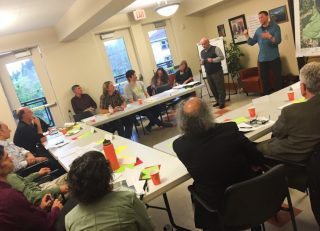
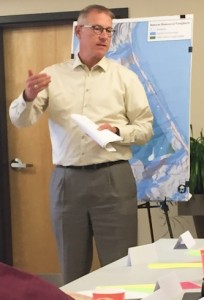
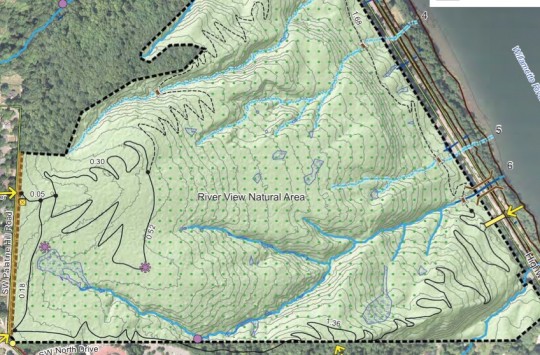
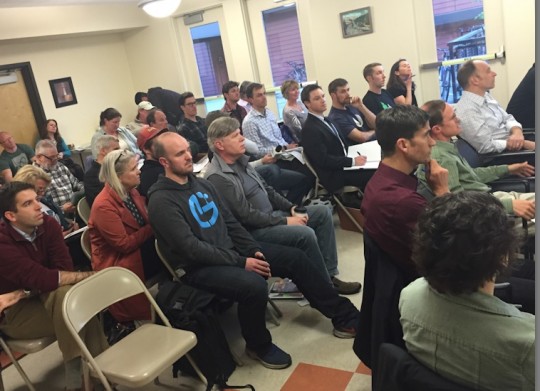

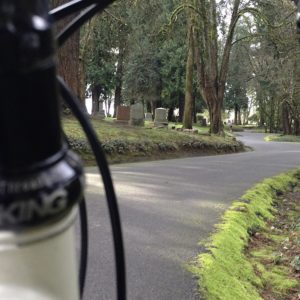
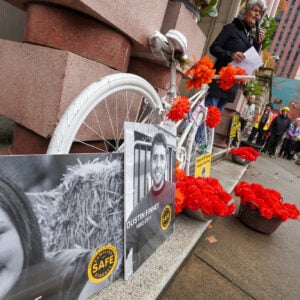
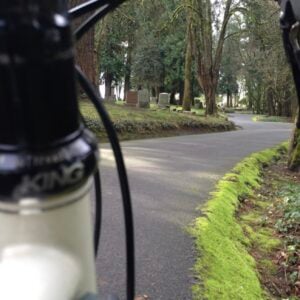
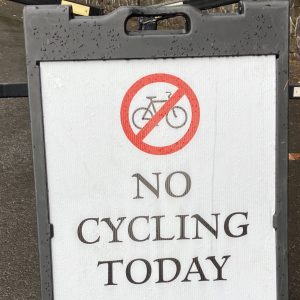
Thanks for reading.
BikePortland has served this community with independent community journalism since 2005. We rely on subscriptions from readers like you to survive. Your financial support is vital in keeping this valuable resource alive and well.
Please subscribe today to strengthen and expand our work.
Any wonders as to why people are advocating for PDX to lose its Platinum status?
Wow. Apparently the City thinks that Joseph Heller’s “Catch-22” was a set of policy guidelines. How they can not collapse under the absurdity of their arguments is beyond me.
The off-road master plan is not passed. There is no reason to trust that it will be. Even if it goes through, we don’t know what it will address of if there will be any sort of tangible progress in the foreseeable future. What we have seen Fritz do in the past is put up red tape for expanding use of Forest Park and banning bikes from RVNA through a closed door process.
They keep wanting us to chase the off-road master plan carrot, but when the carrot has been pulled away under our nose twice by the very people holding the carrot it becomes something not worth chasing. What makes us want to trust them? Not talking about the issue certainly isn’t building any bridges to the community. Referring to something that doesn’t exist doesn’t do much either. I would love to see something proposed from the city that is actually tangible. Please stop the backroom decisions. Stop letting a small group politically control Forest Park. Listen to the public that elected you and offer them something they and future generations can enjoy.
But Charlie Brown I promise I won’t pull the football out from under you this time…trust me! I think Portland Parks thinks the mountain bike community is that stupid.
Good plan by Fritz. Put a ‘temporary ban’ on biking, then craft a permanent trail plan that cannot include biking (because it’s banned), and then remove the temporary ban. Kapow!
Great point Dan. It is a good plan. Devious and terribly cynical, but outstanding in both purpose and execution.
This was my thought too.
Great coverage Jonathan.
Here is your problem Portland:
“Since this PAC is only an advisory body and not able to make decisions…”
You have a two-tier process. The PAC is dog-n-pony show to appease the public while the real decisions are made by city employees, without public input. Compare that with the process outlined here: https://www.minneapolisparks.org/_asset/20rp8c/community_engagement_policy.pdf
As an example of what RVNA could be, look at this trail system in Winona, MN. The park its in (well, 2 parks technically) is almost the same size and terrain as RVNA and the trail builders got 9 miles of trails in that property.
http://www.mtbproject.com/trail/5843518/holzinger-lap
Ah, but we have to offset regular sewage overflows into the Willamette River by keeping rubber tires away from any tributaries.
http://www.oregonlive.com/portland/index.ssf/2014/10/portland_sewage_overflow_619_m.html
Mountain biking for all!
Its a little shocking how blatantly biased they are. I think Abbaté should be awarded a T-shirt that says “I hate bicycles” on the front side, and “I hate Portland” on the back. No need to beat around the bush.
What are examples of cities with really great mountain biking within city limits? Is there anything existing that is comparable to what mountain bike riders in Portland want?
Chapel hill north Carolina.
Do you want the full list? Only counting larger cities (pop. 100,000+) in the US, that is still a lot cities. Everything from NYC to Indianapolis to Louisville to MSP. These are just the trails in the MSP Metro area: http://www.mtbproject.com/directory/166486/minneapolis-and-st-paul
As far as terrain and how that terrain is used by a city, PDX could be a lot like Duluth, MN. http://www.mtbproject.com/directory/166479/duluth Duluth is currently connecting all those dots into a single 100 mile long system called the Duluth Traverse.
Portland is the outlier here. Good mountain bike trail access has become the norm, not the exception, in outdoors-oriented metro areas.
I’ll speak specifically to Minneapolis, since I just moved there from Portland (although I am in Portland the next few days for work). Within the MSP metro area we have THIRTEEN trail systems (I don’t mean just individual trails, but systems) for mountain biking. The Portland metro has ZERO systems with more than a mile or two of singletrack.
From my house in south Minneapolis I can reach all of those by transit and/or bike within 60-90 minutes. Funny, that’s about how long it takes to get from Portland to the nearest mountain biking … IN A CAR!
Yesterday morning before getting on the plane, I rode to the River Bottoms trailhead a mere 6 miles from my house, cranked out a few miles of great dirt riding, and got back home after I started. No car!
And besides the baker’s dozen named systems, there are lots of shorter bits of singletrack all over the place. Just in the few days I have found some really sweet stuff in Minnetonka, Inver Grove Heights and Mendota. Mostly not on maps, but there for the finding. There are tons of great lightly-developed parks and natural areas where one can find lovely bits of trail not officially designated as mountain biking routes, but where parks departments have not banned bikes either, as happens all over Portland.
Oops, edit error. I meant to say “and got back home a couple hours after I started.
Some of these aren’t in the city, but you can pedal to the trails from the city – which is more important to me than if it is contained in the city. Sticking to larger cities:
Los Angeles, CA,
Philadelphia, PA,
NYC has some,
Bay Area has quite a bit,
Seattle/W. Seattle,
Sedona, AZ,
Santa Barbara, CA,
Boston boasts 40 mountain bike trails within 25 miles of the city center,
Phoenix, AZ,
Vancouver, BC,
San Jose, CA,
Santa Rosa, CA, (almost every city in CA really)
SLC, Utah,
Albuquerque, NM,
Colorado Springs, CO,
Chattanooga, TN,
Denver, CO,
Bend, OR,
Minneapolis, MN,
Knoxville, TN
Queenstown, NZ,
Rotorua, NZ…
Really the list goes on.
Even Garland TX has more trails than PDX, starting less than 100 yards from my house… if only I rode MTB, these are some of the few bike-only areas in the entire city. We have more miles of singletrack than we have bike lanes. Imagine if that were true in PDX.
Wissahickon trails in Philly. It is a park the same size as Forest Park that allows mountain biking. Very few problems on shared trails.
Bend, Oregon. Moab, Utah. Helena, Montana. North Vancouver, BC. The list goes on…
If the PAC’s adopted plan is set in stone, how the heck would they revise it? What’s the point of Roth and Abatte saying “set in stone” if the whole thing can change after the City comes to its senses and ends this silly ban?
It’s all double-speak.
This process is an absolute farce. PPR has lost whatever credibility they had (and it wasn’t much before this latest fiasco). The best thing that could happen would be for the process to be suspended until Parks is free to inform the public why they are so tight lipped about the justification for the ban. If it was the lawsuit, then why don’t they come right out and say it? Or is it the terms of the mediation between PPR and BES that coincidentally was just about the time the process was suspended in 2014? Oh yeah, we’re not supposed to know about that!!!
Curious to see how the land use appeal process plays out. No doubt, the City will call for a dismissal. Hopefully LUBA sees through these shenanigans. If they do decide to take on the case, then part of their evaluation will be too review the process/science that was used as a rationale for the bike ban. Unless PPR has a lot more information than they’ve provided, that could prove troublesome for them.
NWTA is definitely holding the high ground here. They’re hanging with a process that has virtually no prospect for a favorable outcome relative to bike access. AND they’re still supporting the Master Plan funding. Wow, does Parks realize what a sh%$ show it would be without NWTA calling for people to stay calm and abide by the rules and process? I think not. At some point, they may just withdraw from the City altogether and focus on continuing to build their relationships with land managers that play by the rules. I can’t believe they’ve stuck with it this long.
WOW
When I heard the PAC committee was being reconvened I was worried that it was just going to be a retread of the same lip service as the last time (that then wasn’t utilized)
The parks dept. is just wasting people’s time…..again.
Cycling is banned. Therefore we can’t talk about cycling?
Give me a break.
Regarding the BP link to the OUTSIDE magazine article, I wonder if the photo chosen by Outside would hurt more than help this discussion of improved mountain bike trail user access. It seems to play into the fears those pushing to restrict access. Just thinking’ out loud.
Agreed. I think that the MTB world’s own marketing (speed, flying dirt, jumps) shoots us in the foot. Sure, it’s compelling imagery for selling bikes or whatever. But for convincing people we care about trails and quiet?
luckily it’s mostly mtb riders that read it…
I don’t know… those comments could be out of a local paper.
This PAC process is a farce, as was succinctly pointed out by Dan above. The community will likely NOT take kindly to the exclusion. The longer bikes are banned, the greater the numbers grow of responsible bike riding nature lovers who elect to ride trails IN Portland.
What about recalling city commissioners?
Who many decades is it going to take.
Ms. Roth stated that this was a “relatively intact watershed” and although this may be true as far as raw land and the drainage basins, it is hardly an intact landscape. The woods have been logged at least once. Noxious weeds infest a large portion of this “natural area” and birds and critters that make habitat out of pristine wilderness undoubtedly find these woods wanting. Of course critters like possums, raccoons, starlings and English sparrows that live off of the cast offs of suburbia can find this to be a sanctuary. Because mountain biking has long been a pastime occurring in the RVNA it is likely that the critters are habituated to the activity and it would not disrupt their life cycles.
As far as it being so unique however the plant/wildlife associations are identical to those found in the forest park. Apparently the recreational opportunities are the same also.
“Ms. Roth stated that this was a “relatively intact watershed” and although this may be true as far as raw land and the drainage basins, it is hardly an intact landscape. …” Granpa
Preservation, conservation, and restoration would seem to be prime objectives the city has in mind for Riverview. If ways could be developed to have mountain biking be compatible and complimentary to those objectives, use of the land for mountain biking would likely have a far better chance of being approved than it apparently does at present.
Mountain biking is in no way in opposition to any of those – that is FUD spread by people like Houle and the city council passive aggressively to keep mtbing out of their backyards. No science, pure NIMBYism.
“Preservation, conservation, and restoration would seem to be prime objectives the city has in mind for Riverview. If ways could be developed to have mountain biking be compatible and complimentary to those objectives, use of the land for mountain biking would likely have a far better chance of being approved than it apparently does at present.”
That’s a gigantic presumption, given that dogs are still allowed.
Not really…if the city comes to decide it’s obliged, as the map accompanying this story may be indicating…to keep what appears to be about 80 percent of the parcel within its perimeter, free of recreational activity.
Yes, but dogs are listed as a one of the highest threats against the ecology of the parks – bikes are not.
FYI, the April 1 draft indicates dogs would not be allowed.
Aah – thanks. Still think hikers should be banned if bikes aren’t allowed, they do about the same amount of damage.
Riverview and Forest Park differ from each other in many ways; heritage, location, size, exposure and more. I don’t know to what extent Forest Park is regarded as a watershed, but apparently the purchase of Riverview was made to some extent, specifically with the idea in mind, of that land being a watershed resource to the city.
With any natural area that cities seek to conserve, ideas that because such areas have deteriorated through the invasion of noxious weeds and misuse, further and increased misuse is somehow justified, are not good ideas on which to make plans for continued use of such areas.
Some cities have an abundance of it on their perimeter, but the area of natural parkland cities have with their boundaries is often very small relative to the population size and the area of land devoted to residence, business and industry. So it is that natural lands within cities, should be due very high levels of protection, if the natural attributes for which they’re being conserved, are hoped to not further decline due to excessive human activity.
And that’s why we want mountain biking access to Forest Park. We want to help protect it in as many ways as possible without being excluded from using it within its intended uses (which includes mountain biking). Mountain biking is not in opposition to any of the things you mentioned – in fact, it is because of mountain biking that I have become more conscious and mindful of the impact I have on the land and world around me.
The first rule of Bike Club is…you do not talk about Bike Club.
It is time that the “Bike Club” talk about it, out loud, with everyone. We need more people to actually get out and ride during the day, so the city cant ignore the fact that ALL trails in Portland are ALREADY multi-use trails. The city has neutered the mountain bike community.
Does Portland really need an Off-Road Cycling Master Plan?
It seems like it’s $350,000 price tag could go a long way towards providing actual biking facilities, trails, and improvements that people want right now!
A master plan sounds great, but what does it really get us? Let’s look at the Portland Bicycle Plan, in any of it’s iterations…1973, 1996, and 2010’s “Portland Bicycle Plan for 2030”. How are we coming along with that additional 662 miles of new bicycle infrastructure that is targeted for 2030? How about that increase to 25% mode share?
What’s that? You mean we can’t even get consistent, reliable, and well thought out infrastructure for bicycles on Portland’s roads, and we’ve been supposedly at it since 1973?! And somehow a Off-Road Cycling Master Plan is going to suddenly provide the citizens in and around Portland with viable off road, single track, mountain biking options?!
The Off-Road Cycling Master Plan will be no more powerful than an advertising brochure. Truly, the existing Portland Bicycle Plan is no better. Granted, they may provide a means of forming cohesive long term planning, but the reality is that they get nothing done on their own, let alone right now.
The reality of Portland’s road bicycling infrastructure is that it was and is a work in process. If the Bicycle Plan’s were truly powerful, Portland’s bicycle mode share would already be at 25%…years ago! While the Bicycle Plan’s may have provided guidance, getting things actually done happened a block at a time by people pushing our city to make it happen. Think Critical Mass, think BTA, think the lone bicyclist just sticking with it to get from their own point A to point B. The truth is we don’t need any plans. The truth is that the solutions for both on the road and off are already known and have been for years. The “Plan” should be to just make it happen. Now.
No, plans are valid. They identify stakeholders (archeological sites, natural features, endangered species, hazard areas, neighbors, opponents proponents), provide cost/benefit analysis, they weigh priorities, identify alternatives, identify funding etc. and they determine schedules for construction. Basically they look for the best way to make something good for the most people, and avoid issues that could come back to bite the project in the butt. Plans are good. Apparently for RVNA the plan does not consider the actual conditions of the site, but a perceived pristine future condition, nor does it consider the most passionate and committed stakeholder, the mountain bike cyclist. Planning and good, comprehensive and fully daylighted plans make for good projects. Plans made behind closed doors for unknown stakeholders, not so much.
Plans are valid, sure, but that didn’t stop PPR from building a lot of skateparks before they had a master plan. It turns out it is a good idea to have some infrastructure to base decisions on before a master plan is laid out.
Precisely my point.
I don’t think anyone, including Fritz, is under the illusion that a Plan is going to create mountain bike paths. And yes, that $350k could actually be put into productive use, but the question would be “where do we spend it?” Fritz would say we need the plan to know.
I think for the reasons Granpa noted, a plan is useful and sometimes necessary. MTB trails is an interesting case though. It seems to me a far cry from the Bicycle Plans, where you have an enormous complex of roads for which to plan a long-term bicycle system. There, the need for a plan is clear to me–to facilitate a coordinated, integrated build-out, as funds become available (which is unfortunately far too slow).
In the case of MTB trails, the need is less obvious from an integration aspect. Do we really have many viable options for MTB trails spots to begin with? Is it a complex/intertwined set of considerations and candidates? Unlike bike infra, MTB projects won’t have much to do with each other, except for the need to spread them around as much as geography/space allows. Relatively few options, and little interrelationship between them certainly suggests that individual projects could just be considered on their own merits.
Why can’t each park be examined on its own?
Can we have bikes here? If yes, add bikes. If no, apologize profusely and show exactly why.
We are planning this park NOW. Why wait, design it for hiking only, then decide if we can shoehorn MTB back in?
Also precisely my point. If we are planning, then let’s plan. It is a waste of time, money, resources, and good will to plan with the exclusion of an interested user group, while telling that user group, “Oh, we’ll maybe plan for including you later”.
Yes, in a roundabout way I was agreeing with your point and dachines’s. I think planning is very important. In the case of the bicycle plan, a master plan seems essential. In the MTB case, not so much–it seems fair to examine the park on its own. Maybe in the bigger scheme, a master plan would be helpful for planning the future areas (where feasible, what priority, equity considerations), but that shouldn’t be necessary to plan THIS park on its own.
We have the “largest city park in the nation” according to some. So yes, we have the space. The damage that is done driving to trails and keeping people fit both should outweigh any sort of perceived (not proven) negative impact on FP or RVNA.
This whole thing is ridiculous, it shouldn’t be a big deal, we have a valid use, but a very loud political minority has been very effective at shutting this process down. As mountain biking continues to gain in popularity (as it is doing worldwide), there will be more and more pressure to gain some access somewhere – but who knows where that will be.
I agree. I can already write the MP summary for free:
“We don’t want bikes in FP because NW neighbors, Audubon, Forest Park Conservancy, and a few other hikers don’t want to share it. But we need to throw cyclists a bone – fortunately we can provide that at Gateway Brown and a few pump tracks. Case closed. Forever. F-you cyclists.”
MTB’ing is not a crime.
Makes me wish I could sign that petition another 3 or 4 times.
“…The silence around cycling is likely due to the pending legal action against the city by the Northwest Trail Alliance. …” maus/bikeportland
An earlier or different legal action is more likely the reason the city and its commissioners are presently unable to talk about use of Riverview for mountain biking. The Northwest Trail Alliance’s action may have added to reasons the commissioners and the city have to stay silent on the issue
Earlier, to a different story about the Riverview issue, I wrote that if the city is simply finding itself unable to use parts of the land parcel for active recreation because of the land being environmentally sensitive, the city could, through the sensitive areas, possibly create trail infrastructure that would isolate the activities from direct contact with the sensitive areas. Certain types of bridge and boardwalk designs can accomplish this. There are existing example in Oregon already, the Columbia Gorge National Scenic Hwy bridges being one. For a smaller scale example, the little 200 acre nature park out in Beaverton is another. Both bridges and boardwalks over sensitive environment there.
By “active recreation” you’re referring to hiking, right?
Exactly. Did you get the email from the FP Conservancy today about the need to repair Wildwood, the hiking-only crown jewel?
Better to not go near the straw men put forth.
Yes: hiking as well as biking, because it seems that from the map accompanying this story, and some of the comments reported from one of the TAC meetings, that out of concern for the watershed value of the parcel, there has been some thought given to keeping the center of the land parcel free of both types of recreation.
Amongst bikeportland readers, I figure there are people that could throw around some realistic ideas for bridge and boardwalk types that could possibly do the job, and make some fair guesses at costs too. Though this one is small, the criteria for what a watershed is, likely would be a determining factor in what and whether any recreational infrastructure through it could be built.
For example, in Bull Run watershed…where the city and communities beyond get their water, there is very little human activity allowed. To my knowledge, recreational activity of any kind in that watershed, is not permitted. The city has had, may still have tours on occasion to the reservoir in the watershed, but that’s it.
Why not build less gravity fed trail along the contours with bridges at creek crossings? The idea of sharing fall line trail with hikers is ridiculous.
As I said. 0 chance this gets reopened. (without suing the city)
We can not talk about bikes when designing the trail plan. Then of course the unfunded master plan will, if it is ever funded, say the existing perimeter trail is not suitable for MTB and we can’t add any (because its an Platonic ideal watershed).
Never going to happen.
The map that accompanies this article is identical to the map that accompanies the article about the TAC. With one exception- the hiker/biker trail has relabeled a hiker only trail. To me, that suggests that the trail route would be the same, bikes or not. It suggests that the TAC didn’t change the route or design characteristics from the first iteration to the second, though I can’t find any more details.
–
If this is the plan put forth by the TAC (and it’s not an unreasonable one, assuming the original intent was to have about 4 miles of rideable singletrack for bikes and hikers), then perhaps Sponsel and Baumann are incorrect about the result being an unsuitable trail, if planning doesn’t account for bikes. Just a thought.
–
I happen to think that the original TAC plan would be quite nice! A steep 4 mile climbing and descending loop with a shorter warm-up loop at the top? All those rideable switchies? I think that sounds like fun!
–
Those points aside, I have to congratulate Sponsel and Baumann for clarifying and revealing the absurdity of Abbate’s agenda for the meeting, and for their excellent work in general. The Orwellian word pretzels that Roth and Abbate had to create were indicators of the failed nature of this process. When grown people can’t even speak up truthfully about the heart of an issue like this, there’s a problem.
I think the TAC was having issues with some of the MTB specific designs we’d want. They did not like grade reversals or banked trails. If you handed this to MTBers you’d get something similar, but perhaps not as fun, or as well armored.
I think accepting this means if we ever get to bike on it it would need a retrofit (more money, or reason to disallow it) or a less fun trail than it could be if we built it the first time.
Why the *$^# would they have issues with grade reversals? Thats the #1 way to prevent channelization and erosion.
I can go find the exact wording they used, but they might have meant what IMBA refers to as “gravity drops.” Hikers wont like those for effort and bike speed related reasons.
https://www.imba.com/resources/trail-building/easy-way-toughen-trails
During a discussion of trail management best practices, the committee noted that the “mountain bike community wants technical trail features, including leaving berms and bigger grade reversals.” The committee decided those type of uses are “not appropriate at this site.”
From: http://bikeportland.org/2015/04/08/parks-bureau-was-for-bike-trails-at-river-view-before-they-were-against-them-136396
I missed that when I read the article. Thank you for pointing that out.
Talk about a lack of scientific approach. Grade reversals are the best way to break up a slope and prevent channelization of water. When the United States Forest Service updated their trail building standards in 2007, they adopted (in whole) IMBA’s 2004 Trail Solutions guidelines. A big part of that was the codifying of grade reversals.
The riverview area has been used for riding bikes for over 20 years? And now they find it to be a valuable natural watershed that needs preservation. Looks like they have to admit that decades of bike riding in it have not proven to be detrimental to it’s watershed quality. So what is really leading this anti-bike agenda?
only one thing to say in response to this: BS….!!!!
Emily Roth and Fritz are close with Audubon and the FP Conservancy. They agree with them and don’t want bikes anywhere except trashy land like Gateway Green. Period. They think it’s purely an adrenaline sport that they hate and want nowhere near them or their hiking friends. So long as they have power, we’re locked out. A simple land grab since there is no ecological or scientific basis – just their aesthetic and leisure-time preference. Oh, and the members of those groups they are tight with.
It sounds like Brian Baumann and Charlie Sponsel did a great job! Thank you! My advice – don’t agree to or ignore the farce. Agree to nothing that is nonsense or is a defacto prohibition, and plan to write a minority descent opinion with any report. Don’t believe that compromising will help – it will not.
If the process goes as it has, I’m not sure I can respect their rules or prohibitions in the future. It’s corrupt and robs any decisions of legitimacy or integrity.
I also have qualms about the Master Plan. I fear that it would simply be a tool for those in power to codify and lock in their preferences for the future. We may be better off waiting until it could be done under people who are less biased against bikes in natural areas.
Fritz is out playing the biking community. Stop playing by her rigged rules. Time to get real. Go after Fritz. Do an end around to Hales. No way he’s happy about the marketing backlash for the city of PDX. He could remove her departments tomorrow. He’s up for re-election. Use that. You want bike support, remove Fritz. Give her the garbage pick up detail. But time to get real. The bike community is getting its ass kicked by one commissioner with an anti-bike agenda. Change strategy.
Do you have any suggestions that aren’t already happening?
Brian, yes.
1) Continue the “protest” rides like the one around the cemetery. Consider the more radical step of a demonstration traffic stop Critical Mass type ride, not substantial, but make the point. Make sure you include a (sorry hold your stomach) photo friendly group of riders–diverse age, race, gender. Keep the hippies and hipsters in the back; push the kids and families and old folks to the front. You can kick me over on the trail later.
2) Foster good contacts with sympathetic journalists at WWeek, OPB, Mercury. See what Joseph Rose thinks about the issue. Get continuing coverage.
3) Hammer away particularly at lack of transparent decision making and the refusal of Director Abbatte to make a statement. Journalists love that stuff. Try to find out if he is being muzzled.
4) Continue to show up at the planning meetings, fill the sign up sheets for testimony, slow down and clog their planning process. If you can muster the people, do the same thing at Council meetings.
5) Put pressure on Fritz and Fish. Show up at their town meetings or other seemingly unrelated events. Ask questions, politely, but constantly.
Hit Fritz on issues that she cares about outside the bike discussion. She’s playing dirty behind the scenes games, the bike community is complaining at workshops or doing mass rides. Come in from left field. What does she care about outside this one topic? Go after her there. Dig through her backround, look for skeletons. Find out why she hates bikes. Change the playing field. Push to get her tossed from her departments. Mobilize other commissioners against her. Isolate her. In the end do not play on her playing field. Change it.
Good suggestions cab and paul g. Now we just need some more volunteers to assist.
Food for thought: $350k is less than what Amanda Fritz has already spent for one reelection campaign.
She plans on doing it again, too.
You will never raise enough to defeat her on this narrow issue. Much as I enjoy the enthusiasm, the various statements made about recall efforts or defeating Fritz or Fish are off target.
It’s very difficult to defeat either of them, and unless I misread the audience, there is not enough people or $$ among the readership to mount any sort insurgency campaign and certainly not to mount a recall.
Again just sharing my own view here, but your point of leverage is a politician who wants to maximize her chance of reelection so is going to be conflict averse, and Council generally that seems awfully quick to sway when they encounter stiff political winds. You have to be that wind.
The petition on Platinum status is brilliant in this regard. It’s unlikely to change the rating, but it strikes directly at the carefully crafted external image of the City as well at at one of our main sources of revenue: tourism.
Do NOT play opp research as Cab suggests. Keep it polite, keep it weird, but keep it regular and noticeable.
OK, just because I was bored in my hotel room I decided to see if I could really back up the claim that I could reach all 13 systems within 90 minutes by bike and/or transit.
So I looked up the actual biking distances, and the actual transit routes and schedules. Not just commuter runs either, but all-day routes that allow you to ride the time of day you want to. As it turns out, I can’t substantiate the claim 100% because, n00b that I am, I didn’t realize how far on the fringes of the metro area two of the venues were.
But I think it still rates as Mostly True. I really can reach 11 of the Twin Cities’ MTB trail systems within 90 minutes from my front door without using a car. And that’s pretty awesome. Come to think of it, maybe one of my goals over the next year should be to do just that.
(* Technically, I can also reach a 12th park easily within 90 minutes if I want to work with the North Star Commuter Rail’s oddball once-per-day reverse-commute schedule, but it’s extremely limiting so I’ll leave it the total at 11).
For those so inclined to listen through the recent PAC meeting, NWTA has posted an audio recording of the entire meeting. All 2.5 hours of it. https://www.youtube.com/watch?v=_JyO2pTi1gI
Remotely related to the issue of this story, but since now that all my comments are moderated ( thank you Jonathan and Michael …!), I thought I’d take the opportunity to introduce an interesting, at least to me, story in the Oregonian about a land use twist permitted out in Washington County.
I’ll just pose a question and post a link to the most recent Oregonian story of today, Sunday the 19th:
Question: Where availability of open land is in relatively short supply, how to find and get 1000 acres of it? In the case of Washington County, or, it could be the city of Hillsboro (haven’t yet closely read the stories.), the use sought for the land would be commercial development…to attract more, big, hi-tech corporations offering employment and tax revenue.
Answer, ‘simple’ that is: Have the land determined to be ‘blighted’.
http://www.oregonlive.com/hillsboro/index.ssf/2015/04/farmland_to_be_declared_blight.html
Though I read an earlier article from last week, about this land use effort, I don’t recall an explanation of what was the criteria for finding the land to be ‘blighted’. The accompanying picture showed a nice green field.
1000 acres close to Hillsboro, would make a nicely sized start on a mountain bike park for that city. Picture seems to suggest the land is flat, though readers of the O may recall a story of a few years back, about a situation that may have been able to help remedy that situation. In short, as part of the major Intel expansion project that’s been going on, many, many thousands of cubic feet of earth had to be removed from the Intel land to prepare for construction. Many thousands of truck loads.
That earth was transported to and dumped on…you guessed, it…arable open farmland in Washington County. It was a somewhat controversial move, because it was thought that the quality of soil dumped, degraded that of the existing farmland. Could have been used to make some really nice hills on flat land.
Of course, Hillsboro and Washington County have in mind, the prospect of bringing in big bucks off the land designated as ‘blighted’.
No thanks – we already have a huge space called Forest Park that would be perfect for mountain biking.
How do we get the blighting process initiated for a 5000 acre city park previously clear cut and currently destroyed by invasive English Ivy?